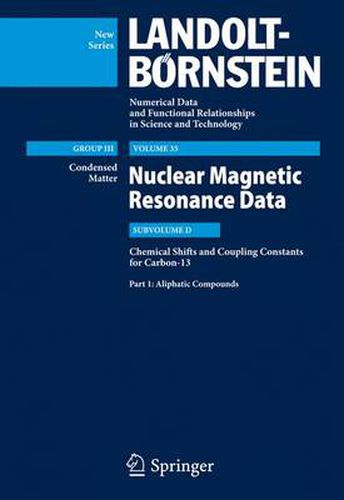Readings Newsletter
Become a Readings Member to make your shopping experience even easier.
Sign in or sign up for free!
You’re not far away from qualifying for FREE standard shipping within Australia
You’ve qualified for FREE standard shipping within Australia
The cart is loading…






The present volume was begun by the late Dr. H.-O. Kalinowski, Justus-Liebig-Universitat, Giessen, 13 Germany who could not continue the work on it. His books about the theory and applications of C NMR are well known and helpful to many chemists. The authors and the editors dedicate the volume to the memory of Dr. H.-O. Kalinowski. Nuclear Magnetic Resonance (NMR) is based on the fact that certain nuclei exhibit a magnetic moment, oriented by a magnetic field, and absorb characteristic frequencies in the radiofrequency part of the spectrum. The spectral lines of the nuclei are highly influenced by the chemical environment, i.e. the structure and interaction of the molecules. Magnetic properties of nuclei have been known since 1924 and the first Nuclear Magnetic Resonance experiment was performed in 1945. NMR is now the leading technique and a powerful tool for the investigation of the structure and interaction of molecules. The present Landolt-Boernstein volume III/35 Nuclear Magnetic Resonance (NMR) Data is therefore of major interest to all scientists and engineers who intend to use NMR to study the structure and the binding of molecules.
$9.00 standard shipping within Australia
FREE standard shipping within Australia for orders over $100.00
Express & International shipping calculated at checkout
The present volume was begun by the late Dr. H.-O. Kalinowski, Justus-Liebig-Universitat, Giessen, 13 Germany who could not continue the work on it. His books about the theory and applications of C NMR are well known and helpful to many chemists. The authors and the editors dedicate the volume to the memory of Dr. H.-O. Kalinowski. Nuclear Magnetic Resonance (NMR) is based on the fact that certain nuclei exhibit a magnetic moment, oriented by a magnetic field, and absorb characteristic frequencies in the radiofrequency part of the spectrum. The spectral lines of the nuclei are highly influenced by the chemical environment, i.e. the structure and interaction of the molecules. Magnetic properties of nuclei have been known since 1924 and the first Nuclear Magnetic Resonance experiment was performed in 1945. NMR is now the leading technique and a powerful tool for the investigation of the structure and interaction of molecules. The present Landolt-Boernstein volume III/35 Nuclear Magnetic Resonance (NMR) Data is therefore of major interest to all scientists and engineers who intend to use NMR to study the structure and the binding of molecules.